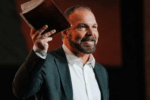It is important to have your personal finances stable before starting a business.
I receive all kinds of calls on our Money Matters radio program. People want to know whether they should buy a new car, how much house they can afford or whether it’s time to start saving for retirement. What they all need is a strategy—a financial life map.
A particularly desperate caller recently confided: “I feel so hopeless. Six collection calls already today, and it isn’t even noon yet! I wish I could just start over.”
My hope is that your situation is not like that of this desperate caller, but if it is, you need to know that there is a way out of the present pain. Whether you have much or little, the seven steps I discuss in this article can guide you to true financial freedom.
Dealing with finances today is like taking a cross-country journey by car. Imagine, for instance, putting a 16-year-old boy behind the wheel in New York City and telling him to arrive safely at a specific destination in San Diego. No GPS, no trial runs, no maps, not even driver’s training—just a slap on the back and a “Good luck! Hope you make it!”
Many people in financial trouble have had only that kind of preparation. Yet to navigate successfully, every traveler requires some understanding of where he is going and how to arrive at his destination.
Does God have anything to say about the best destination for you? What is His role?
Can you trust Him? What principles related to giving and honesty must be followed before you can expect His help on your journey?
These spiritual (and extremely practical) basics unlock the door to God’s supernatural help. The temptation of jumping straight to money-management techniques without building the right foundation dooms us to reliance on our own limited strength and resources.
Even the best money-management advice, if it leaves God out of the picture, cannot get us to the best destination—the one God desires for us. Wealth without contentment never satisfied anyone.
As you study the steps that follow, you may find that you’ve already accomplished some parts of Step 5 (buying a home, for instance) but haven’t completed Step 1. No problem. You don’t need to sell your house. Just focus on completing Step 1 before you tackle other, more advanced objectives.
Step 1: Develop a spending plan.
“The wise man saves for the future, but the foolish man spends whatever he gets.”
Proverbs 21:20, The Living Bible
The two objectives in this step are:
1. Save $1,000 for emergencies. Many people deeply in debt question this, but it is important for two reasons: first, because you must establish the habit of saving, and the sooner, the better; second, because emergencies are inevitable. If you have no savings to deal with auto repairs, broken appliances or uncovered medical expenses, you will be forced into additional debt, continuing the negative pattern that eventually spirals out of control.
2. Start using a spending plan. Rather than being a straitjacket, a spending plan is a tool that can free you from the burden of endless impulse decisions. It also allows you to tell your money where you want it to go rather than wondering where it went. The plan doesn’t need to be complicated, and in time it becomes second nature, prompting many to say, “Why didn’t someone show me this a long time ago?”
This step reveals whether spending changes are required to create a net surplus each month. Without a net surplus, you cannot make progress on any financial goals.
Home equity loans seem like an attractive way to reduce interest costs and simplify payments, but they often postpone the inevitable and actually make it worse. Studies show that most people who eradicate credit card debt through a home equity loan end up creating even higher credit card debt levels within two years because they didn’t address the issue of their monthly negative cash flow. And the second or third time it happens, there is no equity bailout left.
My most recent book, Your Money Map, shows a sample first-draft spending plan as well as an adjusted plan because most people need to fine-tune their plan after living with it for a few months. It also provides a form for creating your own. People who create and follow a balanced spending plan rarely get into financial trouble, and they usually reach their financial goals.
Step 2: Get out of debt.
“The borrower is servant to the lender.”
Proverbs 22:7, NKJV
The two objectives in this step are:
1. Pay off credit cards. Credit cards, with their quick and easy access to unsecured loans, tempt us to turn our backs on the wisdom of earning first and spending later. Combine that with low minimum payments and high interest rates, and you have the equivalent of sod-covered quicksand—grass that looks greener but gives way to a treacherous trap.
According to Bankrate.com, for the estimated 40 percent of cardholders who carry a balance from month to month, a $1,000 debt can turn into a 22-year commitment—and cost thousands more in interest. “People are now in a revolving debt cycle that they’ll never escape,” says Adam Brauer, a debtor advocate and in-house counsel for Debt Settlement USA in Scottsdale, Arizona.
Use the snowball strategy to repay credit cards as quickly as possible. In addition to making the minimum payments on all your credit cards, focus on accelerating the payment of your smallest high-interest credit card first. You will be encouraged as you make progress, finally eliminating that debt.
Then, after you pay off the first credit card, apply its payment toward the next smallest one. After the second credit card is paid off, apply what you were paying on the first and second toward the third smallest credit card, and so forth.
2. Increase savings to one month’s living expenses. This step gets your emergency fund closer to the recommended standard.
Step 3: Stay out of debt.
“Keep out of debt and owe no man anything.”
Romans 13:8, The Amplified Bible
There are two objectives in Step 3:
1. Pay off all consumer debt. This is debt incurred for the purchase of goods or services. Use the same snowball strategy outlined for credit cards.
2. Increase savings to three months’ living expenses.
Step 4: Save for specific needs.
“The plans of the diligent lead surely to plenty.”
Proverbs 21:5, NKJV
There are four objectives in this step:
1. Begin saving for major purchases (home, auto and so on).
2. Begin saving for retirement. You might begin this step earlier if your employer matches your retirement fund contributions. If, while taking Steps 1-3, you are able to make progress and still have some surplus, contribute as much as you can up to the amount your employer matches.
3. Begin saving for children’s educations. Avoiding school debt is important, and it is a blessing when parents are able to help. Many, however, are not in a position to fund any part of their children’s educations.
If you’re one of them, don’t feel guilty. You can do only what you can do, and this may be a blessing in disguise. Research the grant and work opportunities that abound for those who diligently seek them.
4. If you want to start your own business, begin saving for it. The reason for waiting until Step 4 to begin saving for a business is that it is important to have your personal finances as stable as possible.
When you no longer have credit card or consumer debts, your monthly expenses are lower. And having set aside three months’ living expenses, you have a margin in case you need additional income during some of your business’s leaner months.
Believe it or not, it is preferable to start your business before you buy your home, as Proverbs 24:27 says: “Build your business before building your house” (The Living Bible). In other words, create your source of income; then acquire your home.
Step 5: Work toward paying off your home and invest wisely.
“Savings are put into risky investments that turn sour. … The man who speculates is soon back to where he began—with nothing.”
Ecclesiastes 5:13-15, The Living Bible
The three objectives in this step are:
1. Buy an affordable home. “Affordable” means you have saved a down payment of at least 20 percent, and your total housing expenses (mortgage payment, real estate taxes, utilities, insurance and maintenance) will not exceed 40 percent of your income. In areas where housing is extremely expensive, this may require considerable saving, praying and waiting.
2. Begin prepaying your home mortgage. Owning a home with no mortgage greatly enhances financial stability. Some argue that they don’t want to lose the tax advantage of paying interest on a home mortgage, but the advantage is often misunderstood and overrated.
Others propose taking money that could go toward mortgage prepayment and investing it for a higher rate of return. Although the idea is attractive, investing for a higher rate of return is never a sure thing.
Greater returns require greater risks. This includes the possibility of loss. People with investment knowledge may want to direct part of their surplus to an investment while they use the rest to prepay their mortgages. I discuss this in Your Money Map, examining several strategies for paying off your mortgage early and saving tens of thousands of dollars in interest.
3. Begin investing wisely. The fundamental principle for becoming a successful investor is to spend less than you earn and then regularly invest the surplus. Save regularly, seek advice and diversify.
Step 6: Prepare for the future.
“‘You shall know the truth, and [it] shall make you free.'”
John 8:32, NKJV
This step has three objectives:
1. To have your home mortgage completely paid off.
2. To have your children’s educations funded.
3. To confirm that your estate plan is in order. Estate planning is not merely a financial or legal matter; it is a spiritual exercise we work out in God’s presence and for His glory. First, decide how you want to distribute your assets and how to prepare or train your heirs for what they will receive. Only after you have made these decisions should you engage an attorney experienced in estates to draw up the documents.
Step 7: Reap the rewards of faithful stewardship.
“‘Well done, good and faithful servant.'”
Matthew 25:21
In this step, you are able to enjoy the fruit of having handled properly the money God entrusted to you. There are only two objectives:
1. To ensure that your retirement is funded.
2. To be more generous with your time and money.
True financial freedom means much more than a healthy bank account. It means contentment and generosity. No words are adequate to express the joy these bring.
Whether God chooses to bless us with wealth is His business, but we know He wants to bless us with an abundant life, a life that faithfully pursues the pleasure of finding our treasure in Him.
Howard Dayton is the CEO of Crown Financial Ministries and host of the nationally syndicated radio program Money Matters.







Leave a Comment
You must be logged in to post a comment.